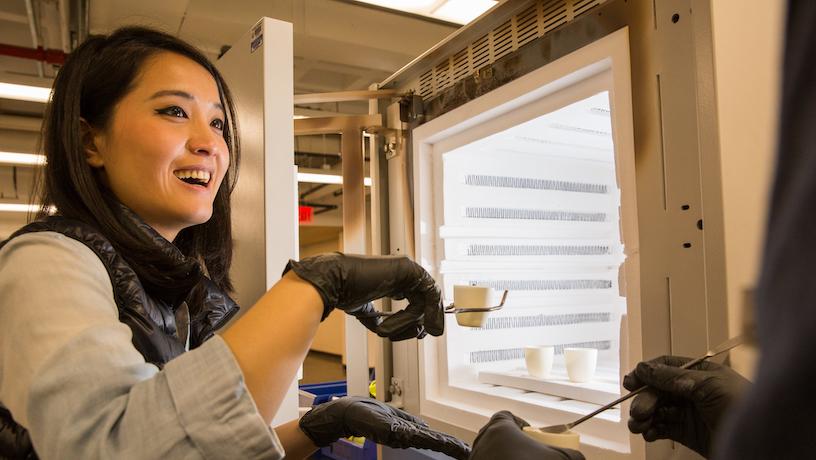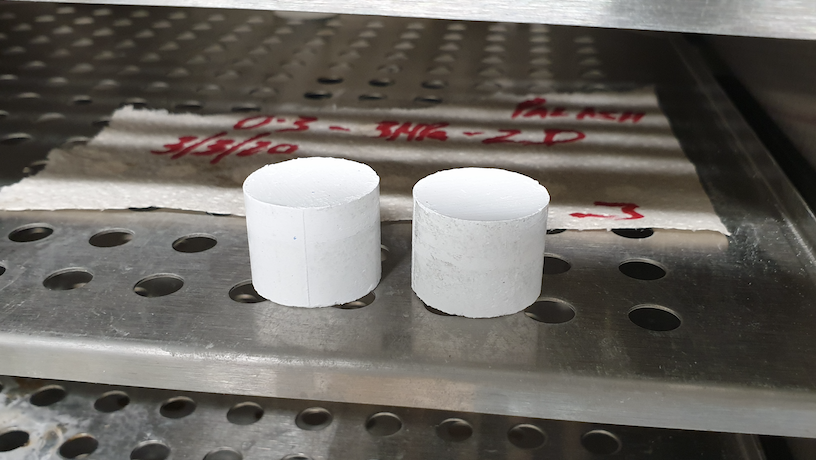Cleaning Up the Construction Industry
Making cement from seawater, recycling slag into rare-earth elements, and other ways to zero out embodied carbon

Kawashima in the lab with Palash Badjatya (CEEM, PhD candidate).
Many people understand the role infrastructure plays in diminishing greenhouse gas emissions by reducing electricity consumption and using more efficient heating and cooling technologies. But few realize how much greenhouse gas is released to produce a building. Such embodied carbon accounts for 11% of anthropogenic carbon dioxide (CO2) emissions globally.
Experts believe the already-massive emissions from the construction industry could double by 2050 without urgent action. Luckily, by harnessing the power of chemical reactions utilizing anthropogenic CO2, we could be on the cusp of turning two of the biggest culprits—steel and cement—into technologies that aren’t just carbon neutral, but potentially carbon negative.
Ah-Hyung (Alissa) Park, director of the Lenfest Center for Sustainable Energy, works with steel companies to convert slag, the waste from steel production, into usable materials through chemical CO2 reactions. She has patented a process that extracts calcium and magnesium from slag and turns them into a solid carbonate, such as limestone. This innovative process also recovers valuable rare-earth elements using a co-precipitation technique. Park, who is also and the Lenfest Associate Professor of Applied Climate Science in earth and environmental engineering, spun this technology into the Columbia Engineering start-up Greenore CleanTech, a company which has since partnered with Baotou Steel Group in Inner Mongolia, China. In spring 2019, the two companies jointly launched the first industrial prototype of its kind, with the implementation of a scaled-up commercial plant slated to follow soon.
The group also partnered with the Wyoming Infrastructure Authority to test another approach they are pioneering to replace standard cement processing.
Cement plants currently quarry limestone and transform it into cement at 1,500 degrees Celsius, a process responsible for 5% of overall emissions. Greenore CleanTech is using an approach that repurposes ash from power plants to produce calcium carbonate as green construction materials through a CO2 mineralization process. Solid carbonates produced from these industrial wastes can be used for concrete production or in paper production, lowering the carbon footprint of each.
“This isn’t a tiny project,” Park says. “We’re transforming entire landscapes of chemicals, fuels, and materials on Earth.”
In that, she isn’t alone. Using renewable energy, Daniel Esposito, associate professor of chemical engineering, and Shiho Kawashima, associate professor of civil engineering, extract raw materials from seawater and use room-temperature processing to convert them into cement that is comparable in strength to Portland cement, today’s industrial standard.
This isn’t a tiny project. We’re transforming entire landscapes of chemicals, fuels, and materials on Earth.

Magnesium cement samples undergoing carbonation curing.
Their method avoids the carbon-emitting steps of Portland cement. It starts when Esposito’s team extracts ocean-based magnesium, the fourth most abundant dissolved ion in seawater. Using a solar-powered electrolyzer (a fuel cell run in reverse), their process splits seawater to form hydroxyl ions that react with magnesium to form a solid magnesium hydroxide that’s easily separated from the water. Once this hydroxide precipitates out of the liquid, they hand it off to Kawashima’s team, which combines the white powder with water and applies light compaction to produce samples that are cured in a CO2-controlled environment. The presence of H2O and CO2 prompt a reaction that binds and solidifies magnesium hydroxide into magnesium carbonate. This process results in a load-bearing structure that can withstand as much compression as conventional cement—and it happens all at room temperature.
Even better, the group estimates their electrochemically-harvested magnesium cement could absorb more than 100 kilograms of CO2 per ton of concrete—rather than release 170 kilograms per ton, the average amount of CO2 released during the production of Portland cement. Next, the team hopes to study the fundamental chemistry and physics underlying the carbonation process, and use that understanding to optimize cement performance and scale-up their process for real-world construction projects.
“We are getting some promising results in the lab, so we plan to do lifecycle analysis and techno-economic analysis to demonstrate the environmental benefits and economic viability of our technology,” says Kawashima. “Demonstrating scalability is critical for the cement and concrete industry.”
